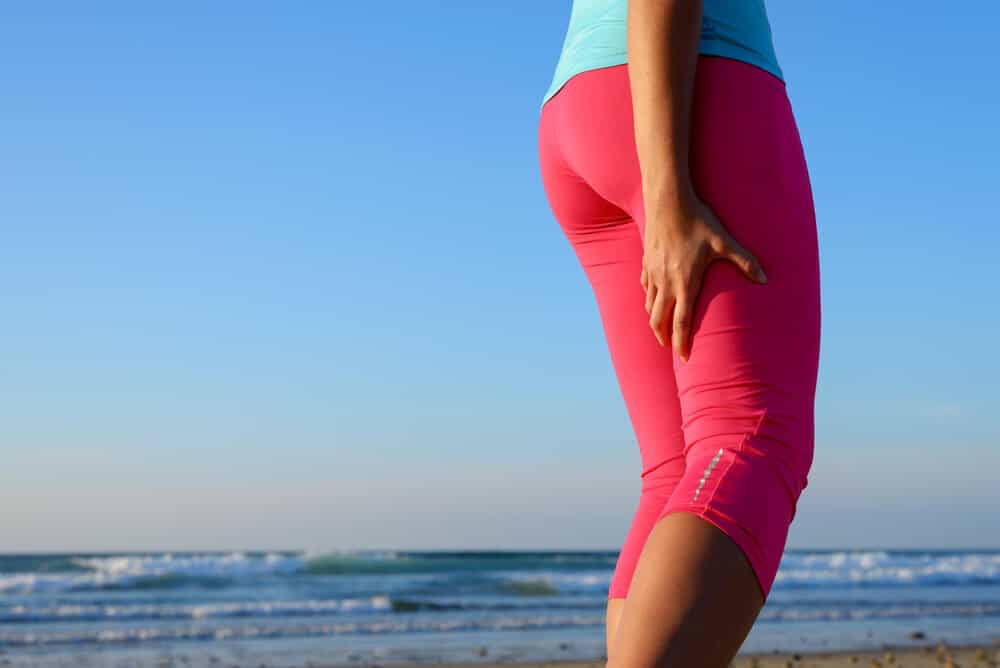Whether you’ve upped the intensity of your training or added several extra miles on your runs, muscle soreness is an all-too-familiar and common side effect of change.
The dull, throbbing pain usually disappears after 24 to 48 hours, but some people can’t afford to take extra days off, especially if they’re on a schedule.
This begs the question: should you put the pain aside and go running with sore legs?
What Causes Muscle Soreness?

When muscles are pushed to work harder than they’re used to, muscle soreness occurs. This side effect is also known as Delayed Onset Muscle Soreness (DOMS).
DOMS occurs when muscle fibers experience microscopic tears.
This damage, coupled with the inflammation that accompanies these tears, causes mild to moderately severe pain, stiffness, and overall fatigue.
Muscle soreness happens to every runner, regardless of the experience level. Even bodybuilders and professional athletes get them.
However, it’s usually more common among beginners and individuals who regularly partake in “eccentric” activities, like running downhill.
It can also occur in the following situations:
- Starting an exercise program for the very first time
- Performing the same activity over and over again without taking breaks
- Adding a new activity or workout to your current program
- Increasing the intensity of your workout; i.e., running harder and faster for longer durations
Running With Sore Legs, Is It Safe?
For the most part, mild to moderate muscle soreness is harmless. It usually means your muscles are getting stronger and adapting to the new activity.
Still, should you go running with sore legs?
When you experience muscle soreness, the best course of action is taking several days off.
DOMS goes away on its own within 24 to 48 hours, so you don’t have to worry about skipping too much of your training.
If you can’t afford to skip several days of training, there are instances where it’s fine to go running with sore legs. Some people even recommend it.
Movement has a sort of analgesic effect on your muscles, as backed by the Journal of Physiology.
Running—and exercise in general—not only reduces pain perception but also has positive effects on mental health. It elevates the mood and reduces stress and feelings of depression.
But unfortunately, running doesn’t cure muscle soreness. After your run, the soreness will return in full force, and may even be worse.
As such, going for a long, vigorous run with DOMS isn’t the brightest idea. You’ll feel good during the run, but the side effects that come after aren’t worth the trouble.
With that said, this doesn’t mean that you should avoid physical activity entirely. Unless you’re suffering from severe DOMS, light activities likely won’t cause any problems.
Such activities include:
- Yoga
- Swimming
- Brisk walking
- Slow, gentle jogging
- Slow to moderate cycling
So, if you can’t miss even a single day of training, replace your schedule with some light cross-training.
You can also focus on upper body strength training and let your leg muscles rest.
Training your upper body is just as essential as training your lower body, as it reduces your risk for injury, strengthens your balance, and improves your arm swing.
How Sore Is Too Sore for Running?
If your legs are sore after running, you might be wondering if you should continue with your workout as normal or take a rest.
The answer here is it depends on the severity of the soreness and symptoms you’re experiencing.
If you’re experiencing mild to moderately mild soreness after a run, you can still go running the next day. However, you should lessen the intensity and duration of your run.
For instance, if you went on a run for five miles and experienced muscle soreness after, decrease the mileage by half the next day.
And, instead of going for a high-intensity run, go with a light jog or an easy run.
You can also take on active recovery instead of going out for a run. Do some low-intensity cardio, such as walking or swimming.
You can likewise partake in light resistance exercises or work on a muscle group you haven’t worked on previously.
If you feel too stiff to do either, stretching works just as well.
Still, beginners should err on the side of caution when exercising and running with sore legs.
Unlike experienced runners, who know just how much is too much, beginners are just starting to get a feel of their bodies.
Deciding to push the pain aside in favor of staying on schedule with the training plan can set a beginner back.
Plus, it dramatically increases the risk of injury.
On the other hand, moderately severe or severe muscle soreness shouldn’t be ignored.
Pushing yourself during a bout of severe muscle soreness may result in an overuse injury, and eventually lead to an array of issues: This includes:
- Patellofemoral Pain Syndrome (PFPS, or Runner’s Knee)
- Medial Tibial Stress Syndrome (MTSS, or shin splints)
- Plantar fasciitis
- Iliotibial band syndrome (ITBS)
- Achilles tendinopathy (Achilles tendinitis)
If you’re experiencing intense muscle soreness, foregoing physical activity is the best course of action.
Give your body the chance to fully rest. This may take several days and sometimes even up to a week, but only in severe cases.
So, how much is too much? Only you can decide. You know your body best, after all.
f the soreness on your legs is anything higher than a 2 or possibly a soft 3 on the pain scale, don’t run.
If the soreness is localized; i.e., isolated to one area, don’t run.
If your body feels overly exhausted, with your energy levels completely depleted and your heart rate elevated, don’t run.
How to Speed-Up Muscle Recovery
If you’ve woken up with stiff muscles and sore legs after particularly intense training, don’t be alarmed. There are multiple ways to alleviate muscle soreness and speed up your recovery.
Take an Ice Bath

Submerging yourself in ice-cold water isn’t what most people call a good time, but it’s actually quite effective against muscle soreness.
Ice baths, also known as cold-water immersion, are a form of cryotherapy that facilitates muscle recovery, reduces inflammation, and improves breathing. It’s also a major mood booster!
If you can’t handle ice baths (don’t worry—no judgments here!), you can instead go swimming or place ice packs on painful areas for 5 to 10 minutes.
Active Recovery Exercises Help
While it’s tempting to stay in bed all day, the lack of movement usually leads to more leg stiffness and discomfort.
This is why we recommend doing some easy stretches and light exercise while resting up.
Try going for a brisk walk or a gentle jog, or simply do some yoga stretches.
Give Yourself a Leg Massage

Massage helps your muscles heal, according to the Journal of Athletic Training.
It’s widely used as a therapeutic modality for muscle fatigue and injury and is perhaps the most popular treatment for exercise-induced muscle damage.
If you’re feeling especially sore, it’s worth getting a massage from a professional.
Self-massage works well, too, however; even if it’s not quite as effective as the latter.
Here’s how to massage your legs:
- Place your palm on your ankle and apply gentle pressure with your fingers.
- Slowly move your hand towards your hips, applying just enough pressure to feel without causing pain. As you move your palm, alternate between light and heavy pressure.
- Once you reach your hips, move your hand back to your ankle and repeat the movement.
- Repeat up to 10 times per leg.
How to Avoid Muscle Soreness After Running
As with most things, prevention is key to keeping yourself free of injury. Here are some top tips to follow to avoid post-run muscle soreness:
- Gradually increase the intensity of your runs by 10% to 20% every week, depending on their difficulty.
- Introduce tempo runs, interval runs, hill runs, and speed work in small, one to two-minute increments.
- Invest in proper running shoes and compression clothing, such as compression socks, compression tights, and compression shorts. Compression clothing is believed to reduce micro-tears that lead to DOMS.
- Don’t skip warm-ups and cool-downs. Start your runs with five-minute exercises and end it with 10 to 20-minute walks and stretches.
- After a particularly intense workout, indulge in a warm bath with Epsom salts. Epsom salts are proven to reduce inflammation in the joints and muscles.
- Massage your legs after a run, even if they don’t hunt. Remember: DOMS occurs 12 to 24 hours after a run, so you won’t feel it as soon as you finish a run.
- Keep yourself hydrated in your runs. For every hour you run, drink around two quarts of water.
- Place an icepack on areas that feel overworked or strained.
- Eat foods high in proteins and carbohydrates, preferably 15 to 30 minutes after a run so the nutrients are absorbed in the bloodstream much quicker.
Final Thoughts On Running With Sore Legs
Running with sore legs increases the chance of injury and may extend your recovery. If you’re experiencing mild muscle soreness, it’s safe to go out for a light jog.
But if the pain is more than just a mild annoyance, it’s best to stay home and rest.
At home, you can partake in active recovery exercises or focus on muscle groups that you haven’t worked on before, so you won’t feel as if you’ve missed an important training day.
